Overview of Desktop CNC Machines
Desktop CNC (Computer Numerical Control) machines represent a compact, accessible evolution of traditional industrial CNC systems, designed primarily for hobbyists, small businesses, makerspaces, and educational settings. These machines use computer-controlled precision to automate the cutting, carving, engraving, and milling of materials such as wood, plastics, aluminum, and even soft metals. Unlike their larger industrial counterparts, desktop CNCs are typically sized for home or office use—often fitting on a workbench with footprints under 2x2 feet—and are powered by stepper or servo motors for axes movement, paired with a spindle motor to drive the cutting tool.
Key features include user-friendly software interfaces (e.g., compatible with GRBL, Mach3, or Fusion 360), modular tool-changing systems, and affordability, with entry-level models starting around $200–$1,000. They excel in prototyping, custom signage, PCB milling, and artistic fabrication, offering tolerances down to 0.01mm. However, limitations like reduced rigidity and power compared to industrial machines mean they're best suited for lighter-duty tasks, where vibration control and material fixturing are critical for accuracy.
Spindle Motors in Desktop CNC Machines
At the heart of any CNC machine lies the spindle motor, which rotates the cutting tool (e.g., end mills, drills, or routers) at high speeds to remove material efficiently. In desktop CNCs, spindle motors come in two primary types:
· Router-Style Spindles: These are essentially high-speed DC or AC routers, like those from brands such as DeWalt or Makita, adapted for CNC use. They typically operate at 10,000–30,000 RPM, deliver 1–3 kW of power, and are air- or water-cooled. Pros include low cost and easy replacement; cons are higher noise, vibration, and collet runout, which can affect precision in fine work.
· Dedicated CNC Spindles: Often ER-collet-based and inverter-driven (e.g., via VFD—Variable Frequency Drives), these provide variable speeds from 0–24,000 RPM or higher, with power ratings of 500W–2.5kW. Water-cooled models (common in models like the Shapeoko or Nomad) offer quieter operation and better thermal stability, while air-cooled ones are simpler but louder. Advanced options include automatic tool changers (ATC) for seamless workflows.
Spindle selection influences torque (for deeper cuts), speed (for surface finish), and compatibility with tool holders like ER11/16/20 collets. Integration involves ensuring the CNC frame can handle the spindle's weight (0.5–5kg) and thrust loads, often requiring upgrades to bearings or enclosures for dust and chip management.
Importance of Choosing the Right Spindle Motor
Selecting the appropriate spindle motor is pivotal to a desktop CNC's performance, longevity, and versatility, as it directly impacts machining quality, efficiency, and safety. A mismatched spindle can lead to tool breakage, poor surface finishes, excessive heat buildup, or frame resonance, potentially voiding warranties or causing machine failure.
Critical factors include:
· Material Compatibility: High-RPM spindles suit soft materials like foam or acrylic for clean edges, while high-torque, lower-RPM models handle metals better to avoid deflection.
· Power and Speed Range: Insufficient power stalls during feeds, while overpowered spindles strain the machine's mechanics.
· Cooling and Noise: Water cooling prevents thermal expansion errors in prolonged jobs, and quieter operation is essential for home use.
· Cost vs. ROI: Premium spindles (e.g., $200–$800) reduce downtime and enable advanced features like ATC, justifying investment for professional output.
· Safety and Maintenance: Features like automatic shutoff, balanced rotors, and easy collet changes minimize risks from runout or debris ingress.
Ultimately, the right spindle aligns with your workflow—e.g., a 1.5kW water-cooled ER20 for general-purpose milling—enhancing precision, expanding material options, and maximizing the desktop CNC's potential as a reliable production tool. Poor choices often result in frustrating limitations, underscoring the need for thorough research into specs, user reviews, and compatibility testing.
What Is a CNC Spindle Motor?
Definition and Function of a CNC Spindle Motor
A CNC spindle motor is the high-speed rotary drive system at the core of a Computer Numerical Control (CNC) machine, responsible for spinning the cutting tool—such as end mills, drills, or engraving bits—at precise and variable speeds to remove material from a workpiece. Essentially, it converts electrical energy into mechanical rotation via an electric motor (typically AC or DC brushless types), often paired with a Variable Frequency Drive (VFD) for speed control. In desktop CNCs, spindles range from 500W to 2.5kW, achieving RPMs of 5,000–48,000, and use collet systems like ER11, ER16, or ER20 to securely hold tools with runout tolerances under 0.01mm for accuracy.
The primary function is to provide controlled torque and rotational force, enabling operations like milling, routing, drilling, and engraving. It integrates with the CNC's controller (e.g., via GRBL or Mach4 software) to synchronize speed with feed rates, depth of cut, and material type, preventing tool deflection or breakage. Advanced spindles include sensors for automatic tool length measurement, vibration monitoring, and overload protection, ensuring consistent performance across jobs from prototyping PCBs to carving aluminum parts.
How It Powers CNC Cutting and Engraving
The spindle motor powers CNC processes by generating the kinetic energy needed for material removal through shear forces. During cutting, the spinning tool's flutes or edges abrade, chip, or vaporize material at the point of contact, with efficiency dictated by RPM (higher for fine finishes on plastics or woods), torque (for plunging into metals), and chip load (material removed per tooth revolution). For instance, engraving delicate patterns on brass requires 20,000+ RPM for clean V-grooves, while roughing out hardwood might use 10,000 RPM with high torque to evacuate chips without bogging down.
Power delivery is managed via the VFD, which adjusts frequency and voltage to the motor's stator windings, enabling dynamic speed changes mid-job—e.g., slowing for heavy cuts or ramping up for finishing passes. Cooling prevents thermal runaway, maintaining spindle rigidity and bearing life (often 10,000+ hours). In engraving, the spindle's precision rotation minimizes burrs and heat-affected zones, while in cutting, it supports multi-axis interpolation for 3D contours. Integration with dust collection and lubrication systems further enhances tool life and surface quality, making the spindle the "workhorse" that translates G-code instructions into physical output.
Air-Cooled vs. Water-Cooled Spindle Motors
Desktop CNC users must choose between air-cooled and water-cooled spindles based on noise, heat management, maintenance, and application. Both types use high-speed bearings and ER collets but differ in thermal dissipation:
· Air-Cooled Spindles: These rely on built-in fans or external blowers to circulate ambient air over fins or the motor housing, dissipating heat from operation. Pros include simplicity, no need for pumps or coolant reservoirs, lower upfront cost ($100–$400), and portability—ideal for hobbyists or intermittent use. They handle speeds up to 24,000 RPM effectively for woods and plastics but generate significant noise (70–90 dB) and struggle with prolonged high-load tasks, leading to faster bearing wear and potential thermal expansion errors (up to 0.1mm). Dust ingress is a common issue, requiring frequent cleaning.
· Water-Cooled Spindles: A sealed pump circulates coolant (often distilled water with anti-corrosion additives) through internal channels around the motor and bearings, offering superior heat rejection for stable operation at 1–2kW over hours. Pros are quieter performance (50–70 dB), better precision in metals or extended sessions, and longer lifespan (20,000+ hours), making them suitable for professional setups like the Genmitsu or BobsCNC kits ($200–$600). Cons include added complexity (pump, hoses, reservoir), risk of leaks or pump failure, and higher power draw for the cooling system. They're essential for heat-sensitive materials to avoid warping or poor tolerances.
In summary, opt for air-cooled for budget, light-duty engraving; water-cooled for demanding milling where precision and runtime matter. Hybrid or oil-mist systems exist but are rarer in desktops. Always match cooling to your machine's enclosure and ambient conditions for optimal results.

Key Factors to Consider When Choosing a CNC Spindle Motor
Power and Torque
Power, measured in watts (W) or kilowatts (kW), indicates the spindle motor's capacity to drive cutting tools through materials, while torque (in Nm) measures rotational force for overcoming resistance during cuts. For desktop CNCs, spindles typically range from 300W (light engraving) to 2.5kW (aluminum milling), with torque peaking at lower RPMs for heavy stock removal. Insufficient power causes stalling or burning, while excess strains the machine frame.
Key considerations:
· Application Matching: 500–800W suits woods/plastics; 1.5–2kW for metals to maintain feed rates without deflection.
· VFD Integration: Ensure the Variable Frequency Drive supports the motor's power rating for smooth torque curves—e.g., constant torque up to base speed, then constant power.
· Efficiency: Look for brushless AC motors with 80–90% efficiency to minimize heat and energy waste. Test via specs or user benchmarks for real-world chip loads (e.g., 0.05–0.2mm per tooth).
Higher torque enables deeper cuts (e.g., 5–10mm passes in soft metals), but balance with your CNC's rigidity to avoid vibrations.
Speed (RPM Range)
RPM (revolutions per minute) determines cutting speed and finish quality, with desktop spindles offering 5,000–48,000 RPM via VFD control. Higher speeds excel in fine engraving (e.g., 20,000+ RPM for clean acrylic edges), while lower ranges provide torque for roughing.
Factors to evaluate:
· Variable Control: Prioritize 0–24,000 RPM minimum for versatility—e.g., slow for tapping threads, fast for PCB milling.
· Material Optimization: Calculate surface speed (SFM = RPM × tool diameter × π / 1000) to match material; steels need 300–600 SFM, plastics 1,000+.
· Tool Compatibility: Ensure RPM avoids resonance frequencies that amplify chatter, and check max ratings to prevent bearing failure.
Wide ranges via inverters allow dynamic adjustments in software like Fusion 360, reducing tool wear and improving tolerances to 0.01mm.
Cooling System
Cooling prevents overheating, which causes thermal expansion (up to 0.05mm errors), bearing degradation, and power loss. Air-cooled uses fans for simplicity; water-cooled circulates fluid for efficiency.
Selection tips:
· Duty Cycle: Air-cooled for <2-hour sessions (noisy, 70–90 dB); water-cooled for continuous use (quieter, stable temps <40°C).
· Environment: Water systems need pumps (5–10W) and reservoirs; guard against leaks with submersible pumps and filters.
· Performance Impact: Water cooling sustains high RPM/torque longer, ideal for metals; air suits dry, dusty shops but requires dust boots.
Choose based on noise tolerance and runtime—water for precision pros, air for hobbyists.
Collet Size Compatibility
Collets (e.g., ER11, ER16, ER20) grip tools securely, with size dictating shank diameter range and runout (<0.005mm ideal). ER11 handles 0.5–7mm shanks (fine engraving); ER20 up to 13mm (versatile milling).
Considerations:
· Tool Ecosystem: Match to common bits—ER16 for 1–10mm balances precision and strength.
· Runout and Taper: Precision collets with CNC-ground tapers minimize vibration; replace nut/wrench sets for consistent clamping.
· ATC Readiness: Larger collets (ER25+) support automatic tool changers but add weight.
Verify machine mount (e.g., 43mm or 52mm flanges) and include extras for quick swaps, ensuring compatibility with suppliers like Amana or Whiteside.
Precision and Vibration Control
Precision hinges on low runout, balanced rotors, and ceramic/hybrid bearings for <0.01mm accuracy. Vibration from imbalance or resonance reduces tool life and causes chatter marks.
Key aspects:
· Bearing Quality: Angular contact bearings handle axial loads; ABEC-7+ ratings for high-speed stability.
· Balance Grade: G2.5 or better per ISO 1940 for minimal harmonics at 24,000 RPM.
· Damping: Integral dampers or frame isolation; test with dial indicators for <0.005mm TIR (total indicated runout).
Sensors for real-time monitoring enhance safety. Prioritize for fine work like jewelry or circuits.
Durability and Maintenance
Durability ensures 10,000–30,000 hours of service, influenced by IP-rated enclosures (IP54+ for dust/chip resistance) and sealed bearings. Maintenance involves lubrication, collet cleaning, and VFD calibration.
Factors:
· Build Quality: Aluminum housings with anodizing resist corrosion; check MTBF (mean time between failures).
· Serviceability: Modular designs for easy bearing swaps; water systems need coolant changes every 6 months.
· Warranty and Parts: 1–2 year coverage; availability of OEM replacements critical for downtime.
User reviews highlight longevity—e.g., Chinese spindles may need upgrades. Invest in quality for ROI, factoring ambient humidity and usage logs for predictive maintenance.
The Growing CNC Market in America
The Computer Numerical Control (CNC) market in the United States is experiencing robust expansion, fueled by advancements in automation, the resurgence of domestic manufacturing, and a surge in demand for precision tools across industries. As of 2025, the U.S. CNC router market—encompassing desktop and industrial models—is valued at approximately USD 1.5 billion, projected to reach USD 3.2 billion by 2035, reflecting a compound annual growth rate (CAGR) of 7.13%. This growth outpaces the global CNC router market, which is expected to expand from USD 765.80 billion in 2025 to USD 1,101.37 billion by 2034 at a CAGR of 4.12%. Key drivers include policy incentives like the Manufactured in America Act of 2024, which offers tax breaks for investments in CNC equipment, alongside a $15 billion federal push for manufacturing technology and workforce training. These factors are bolstering reshoring efforts, particularly in automotive, aerospace, and woodworking sectors, where CNC routers enable high-precision, customizable production. Additionally, the integration of AI, IoT, and robotics is lowering barriers to entry, making CNC accessible beyond large factories to small workshops and hobbyists.
North America's dominance in the market, accounting for nearly 30% of global share, stems from its established ecosystem of innovators like Haas Automation and Techno CNC Systems, which in 2025 launched affordable multi-axis and education-focused models. Challenges persist, including high initial costs (entry-level machines at $1,000–$10,000) and skilled labor shortages, but trends toward modular, user-friendly designs and financing options for used equipment are mitigating these hurdles. Overall, the U.S. CNC market's trajectory signals a shift toward smarter, more sustainable manufacturing, with desktop variants playing a pivotal role in democratizing access.
Demand for DIY and Professional Desktop CNC Routers
Demand for desktop CNC routers in America has skyrocketed, bridging the gap between hobbyist experimentation and professional prototyping, with sales projected to contribute significantly to the broader CNC router segment's 4.41% CAGR through 2033. These compact machines (typically under 4x4 feet) appeal to the DIY maker movement, small businesses, and educational institutions, driven by the rise of e-commerce platforms like Etsy for custom goods and a cultural emphasis on personalization. In 2025, the tabletop CNC milling subset alone is valued at USD 1,291.3 million globally, with the U.S. capturing over 40% due to its vibrant maker communities and STEM initiatives.
For DIY users, affordability and ease of assembly are paramount. Entry-level kits like the Sainsmart Genmitsu 3018 PROVer ($200–$500) dominate, offering engraving and milling for woods, plastics, and soft metals, ideal for home crafters producing signs, decor, or PCB prototypes. The DIY ethos is amplified by open-source designs like the MPCNC (Mostly Printed CNC), which hobbyists build for under $1,000 using 3D-printed parts, fostering innovation in garages and makerspaces. Demand here is tied to sustainability—precision cuts reduce waste—and the post-pandemic boom in home-based entrepreneurship, with over 50% of new users citing customization for niche markets like personalized gifts.
Professional desktop models cater to small-scale manufacturers and workshops, emphasizing scalability and integration. Machines like the Shapeoko 4 ($1,500–$3,000) or Onefinity Elite Series ($2,000+) provide rigidity for aluminum milling and 3D contouring, supporting applications in signage, cabinetry, and aerospace prototyping. U.S.-made options from ShopSabre and CAMaster ($3,000–$10,000) highlight American craftsmanship, with features like automatic tool changers (ATCs) enabling unattended operation for 24/7 production. Professionals value these for ROI—reducing labor by 30–50%—and compatibility with software like Fusion 360. Market data shows 43% SME adoption, with furniture and signage industries leading at 49% and 44% usage, respectively. Overall, demand is surging 15–20% annually in the U.S., propelled by accessible financing and a 46% share in education/training end-uses.
| Segment | Key Drivers | Popular Models (2025) | Price Range | Applications |
| DIY/Hobbyist | Affordability, ease of use, maker culture | Genmitsu 3018, Shapeoko 4 (entry) | $200–$1,000 | Engraving, prototyping, crafts |
| Professional | Precision, scalability, integration | Onefinity Elite, ShopSabre IS-M | $1,500–$10,000 | Signage, furniture, small-batch manufacturing |
Trends in Small Workshop Automation
In 2025, small workshops in America are pivoting toward hybrid automation, blending CNC routers with AI, IoT, and robotics to enhance efficiency without overhauling operations. This shift addresses labor shortages—projected to affect 2.1 million manufacturing jobs by 2030—and rising customization demands, with automation adoption in SMEs up 25% year-over-year. Compact desktop CNCs with plug-and-play features are central, enabling 24/7 runs and reducing setup times by 40%.
AI and Predictive Maintenance
AI integration in desktop CNCs, like those from Haas, forecasts tool wear and optimizes feeds via real-time data, cutting downtime by 30% and boosting productivity in resource-limited shops. Cloud-based platforms provide instant quoting and remote monitoring, ideal for solopreneurs scaling via Etsy or local contracts.
Collaborative Robotics (Cobots)
Affordable cobots ($10,000–$20,000) pair with CNCs for automated loading/unloading, as seen in Techno systems, allowing one operator to manage multiple machines. This trend supports hybrid workflows, merging manual artistry with digital precision for bespoke woodworking.
Sustainability and On-Demand Production
Eco-focused trends include recyclable material machining and energy-efficient spindles, aligning with green incentives. On-demand platforms like MakerVerse enable small runs, with 3D-CNC hybrids reducing waste by 20%.
Multi-Axis and Compact Designs
5-axis desktop models for complex parts are gaining traction in workshops, with 3-axis still dominant at 54% market share for simplicity. Barriers like costs are easing via modular upgrades and financing, positioning small U.S. workshops as agile competitors in a $100+ billion global CNC ecosystem.
These trends underscore a democratized future: small workshops leveraging automation for resilience, with U.S. policies accelerating adoption to sustain manufacturing leadership.
Top 10 Desktop CNC Spindle Motors in America
In the booming U.S. CNC market, desktop spindle motors are essential for hobbyists and professionals seeking precision, reliability, and value. Based on 2025 reviews from sources like CNCSourced, Amazon, and Reddit's hobbyist communities, this curated list highlights top performers for woodworking, engraving, and light metalwork. Selections prioritize power, noise levels, ease of integration, and user feedback, with prices ranging from $50–$500. All are compatible with popular frames like Shapeoko or 3018 kits.
1. Zhong Hua Jiang CNC Spindle Motor
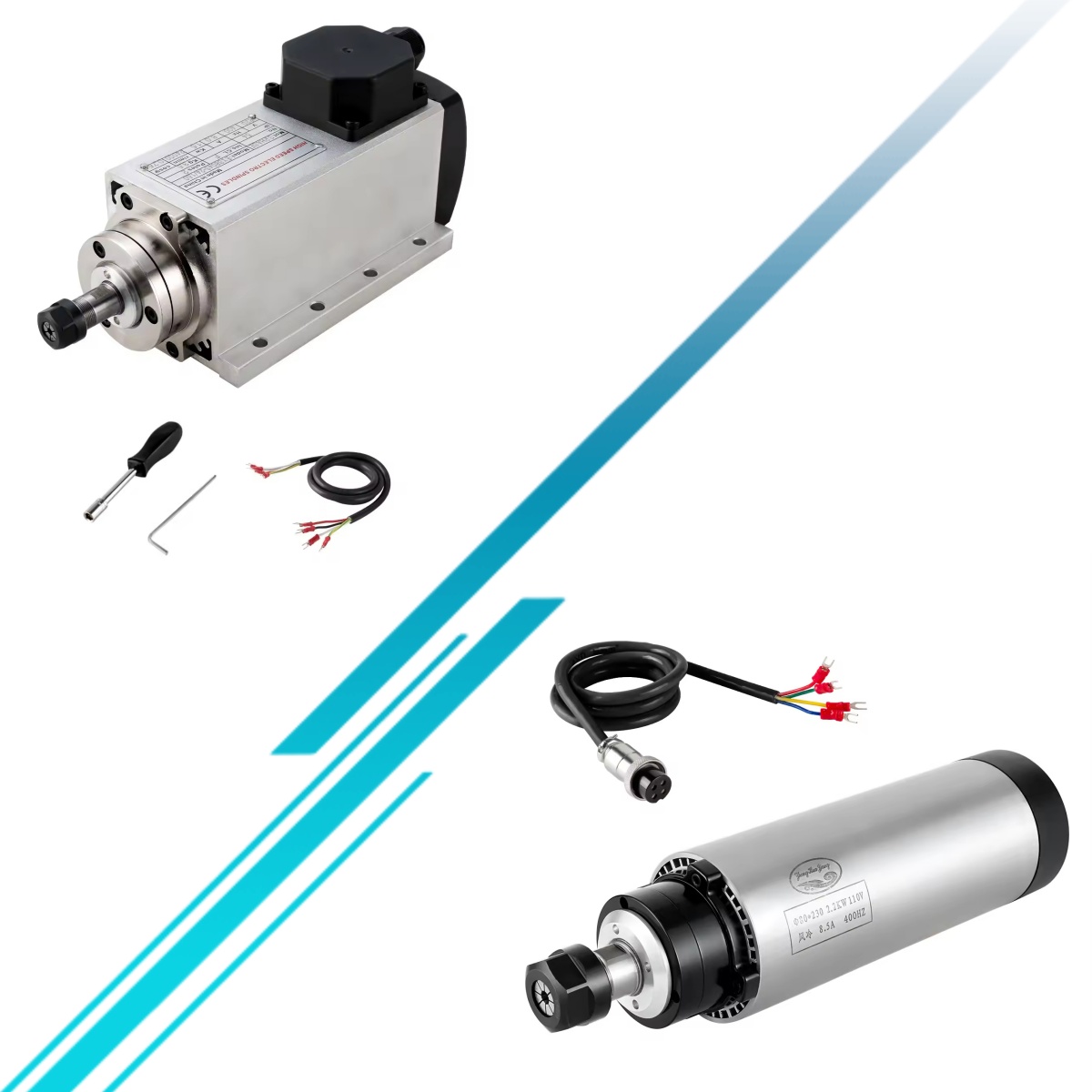
Overview and Brand Background
Zhong Hua Jiang, established in 2000 under Huajiang, is a leading Chinese manufacturer of CNC spindles, VFDs, and routers, exporting to over 100 countries including the U.S. Known for affordable, high-volume production, the brand emphasizes OEM/ODM customization and has earned CE and ISO 9001 certifications. Their 20,000 sq ft facility produces reliable entry-to-mid-level spindles, with the RT series gaining traction for desktop setups via Amazon and AliExpress. In 2025, it's a top budget pick for American makers, praised for quick U.S. shipping and responsive support.
Key Features and Specifications
Patented Air-Cooled Design
Features an innovative fan-assisted cooling system with optimized airflow channels for efficient heat dissipation, maintaining stable temperatures below 50°C during extended runs without the complexity of water pumps. This design reduces thermal expansion errors and supports consistent torque output.
Precision Bearings
Equipped with high-grade angular contact ball bearings (e.g., P4 or ABEC-7 equivalent) for minimal runout (<0.005mm) and smooth rotation, minimizing vibration and ensuring quiet operation at 60–75 dB even at peak speeds.
Long Lifespan
Rated for up to 2 years (or ~5,000–10,000 hours) under 8-hour daily use, thanks to sealed, grease-lubricated bearings and durable aluminum housings resistant to chips and dust (IP54 rating).
VFD Compatibility
Fully supports Variable Frequency Drives for precise 0–24,000 RPM control (common in 1.5kW models), with 110V/220V input, ER11/ER16 collets (1–10mm shanks), and plug-and-play wiring including aviation plugs. Power ratings span 500W–2.2kW; kits often include mounts, collets, and tools. Dimensions: Typically 65–80mm diameter x 150–200mm length; weight 2–4kg for easy desktop integration.
Why It’s Ideal for Precision Engraving and Cutting
This spindle excels in fine work due to its low runout (<0.005mm) and dynamic balancing, reducing vibration for clean edges on acrylic, wood, and PCBs. The water-cooling maintains stable temps (<40°C) for prolonged sessions, preventing thermal drift that causes inaccuracies in engraving. High torque at low RPMs suits detailed V-carving, while variable speeds via VFD allow seamless shifts from roughing (10,000 RPM) to finishing (24,000 RPM), ideal for tolerances under 0.01mm.
Applications and Customer Feedback
Versatile for signage, custom jewelry, and PCB prototyping; handles woods, plastics, aluminum, and soft metals without stalling. Amazon users rate it 4.5/5 (200+ reviews), lauding quiet operation (50–70 dB) and value: "Transformed my 3018 into a pro tool—precise cuts in brass with no chatter." Minor gripes include occasional VFD setup tweaks, but support resolves quickly. ROI shines for small shops, with 10,000+ hour lifespan.
Click here to buy spindle motors on Amazon.
2. Stepcraft HF-500 Spindle Motor
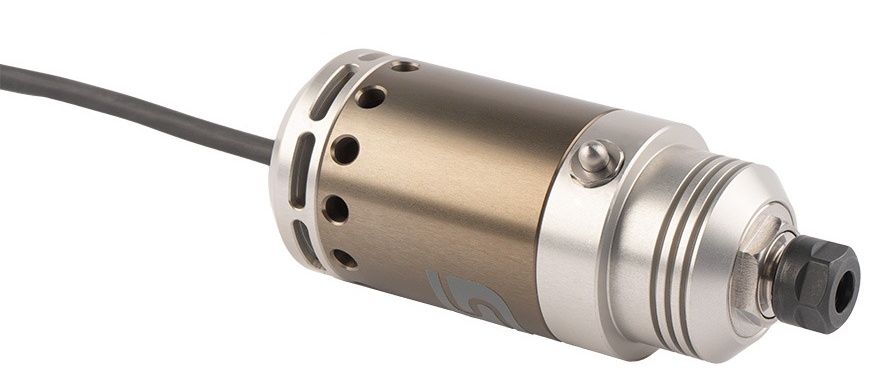
Brushless Design
The HF-500 v2 features a high-torque asynchronous brushless motor, eliminating carbon brushes for maintenance-free operation and consistent performance. Triple angular-contact ball bearings (ABEC-7 grade) ensure concentricity under 0.01mm, with a rigid aluminum housing resisting deflection during feeds.
Extremely Quiet Operation
At 50–65 dB (even at 20,000 RPM), it's whisper-quiet compared to brushed routers (80+ dB), thanks to balanced rotors and sealed bearings. The redesigned control unit supports 6 languages and PWM/analog signals for seamless GRBL integration, minimizing electrical noise.
Advantages for Woodworking and Metal Engraving
For woodworking, its 500W torque handles 5–10mm passes in hardwoods without bogging, while 5,000–30,000 RPM range suits engraving aluminum or brass with <0.005mm precision. ER11 collets (up to 7mm) support fine bits for detailed joinery or inlays; air-purge option extends bearing life in dusty shops.
User reviews on Stepcraft forums and YouTube (4.7/5) highlight its stability: "Cut flawless mortises in oak—silent enough for garage use." Ideal for MPCNC upgrades, though collets sold separately.
3. Vevor ER11/ER16 Air-Cooled Spindle Motor
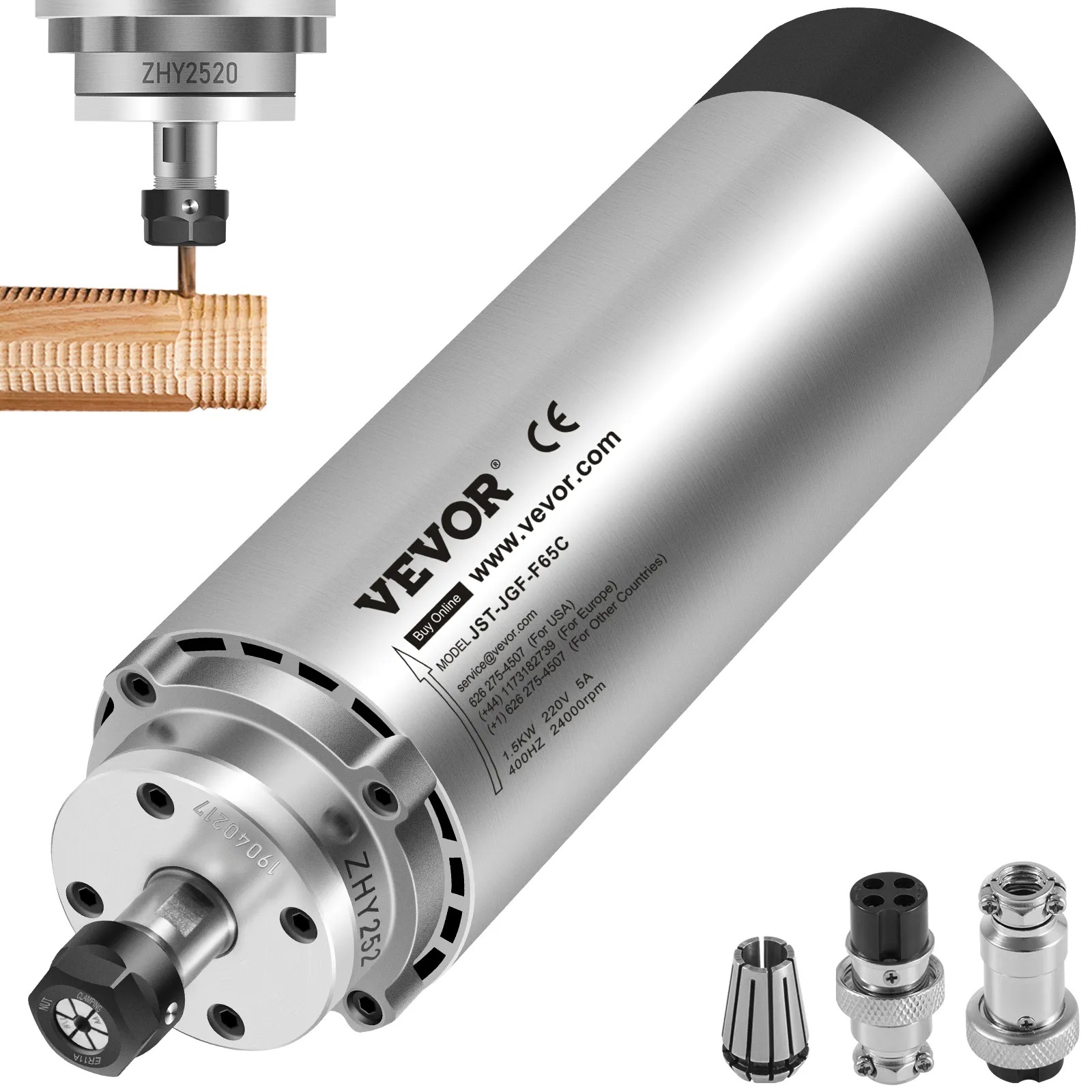
Budget-Friendly Choice for Hobbyists
At $100–$150, Vevor's 0.8–1.5kW kits offer pro features without premium pricing, including VFD and collets—perfect for entry-level users on 3018 or Genmitsu frames.
Lightweight and Easy to Install
Weighing 2–3kg with a 65mm diameter, it mounts in minutes via included clamps; no coolant setup needed. ER11 (fine engraving) or ER16 (versatile milling) options fit 1–10mm shanks, with <0.002mm runout for accuracy.
Best Suited for Small CNC Routers
Optimized for compact machines, it delivers 12,000–24,000 RPM for efficient cuts in foams, woods, and soft plastics; 4 bearings ensure smooth runs up to 400Hz. Amazon feedback (4.4/5, 500+ reviews) praises simplicity: "Plug-and-play on my 3018—lightweight beast for prototypes." Dust-resistant but louder (70 dB) for short sessions.
4. GDZ-65-800W Spindle Motor
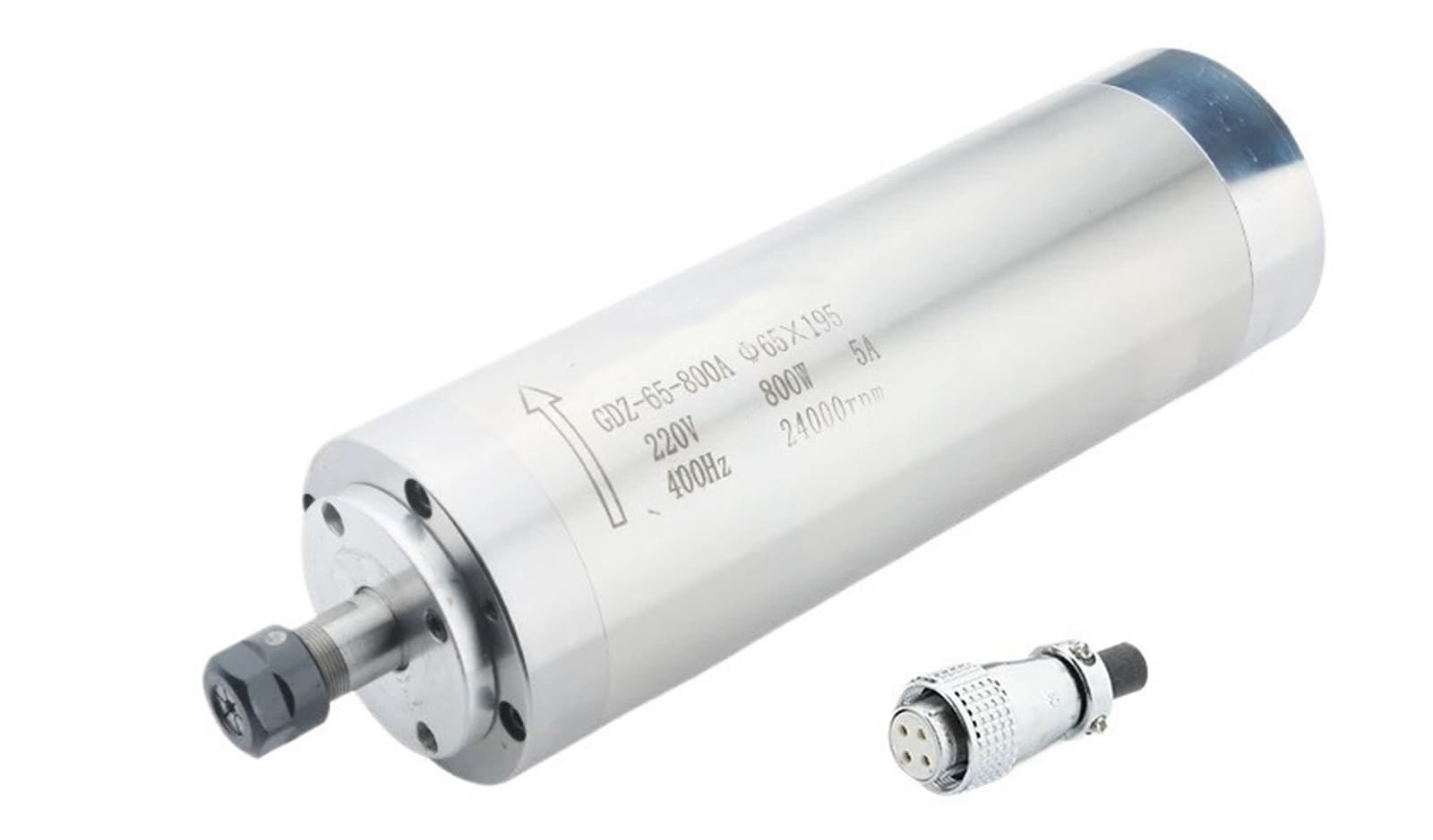
Compact Design and Strong Torque
This 65mm x 158mm water-cooled unit packs 0.33Nm torque into a 2.6kg frame, ideal for tight Z-spaces on desktop routers like Shapeoko.
Smooth Performance for Fine Carving
Up to 24,000 RPM with <0.01mm runout and ER11 collet ensures vibration-free engraving; 2x P4-grade bearings (7002C DT) deliver silky operation for intricate patterns.
Long Service Life with Low Noise
Grease-lubricated for 10,000+ hours; water-cooling keeps noise at 55 dB. Reviews on AliExpress (4.6/5) note durability: "Ran 200 hours on plywood without hiccups—quiet and cool." Suits woods, PVC, and light aluminum.
5. RATTMMOTOR 500W CNC Spindle Kit
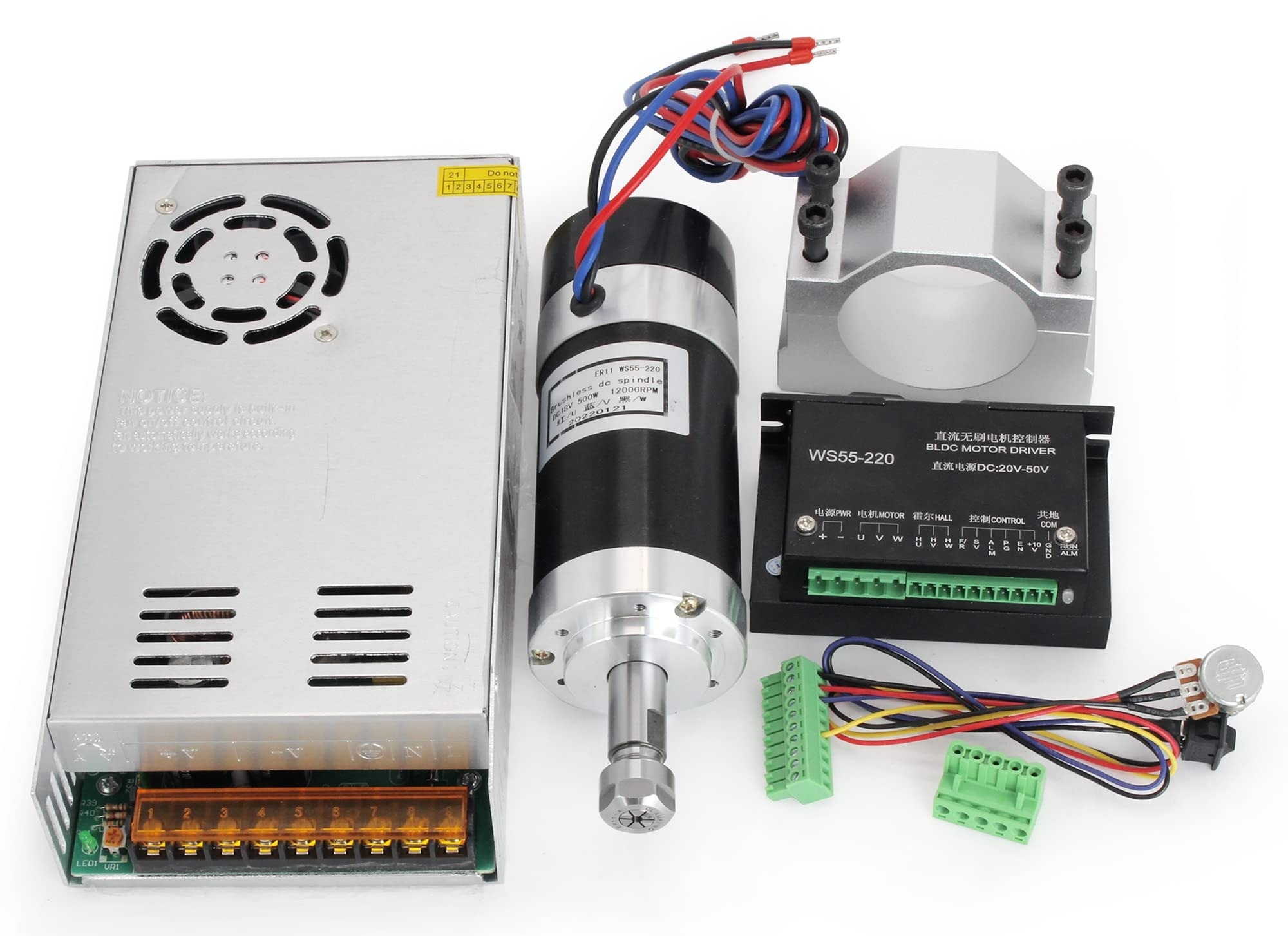
Affordable and Beginner-Friendly
Under $100, this kit includes VFD, power supply, and clamps—plug-and-play for novices on 3018 or Workbee builds.
Includes Speed Controller
48V DC operation with 0–12,000 RPM dial; supports Mach3 PWM for easy G-code control, no complex wiring.
Great for Learning and DIY Projects
0.6Nm torque handles engraving woods/plastics; ER11 collet for 1/8" bits. Amazon users (4.5/5, 300+ reviews) love it: "Perfect starter—cut acrylic signs flawlessly, no stalls." Compact (52mm) for mini routers.
6. FoxAlien 300W Spindle Motor
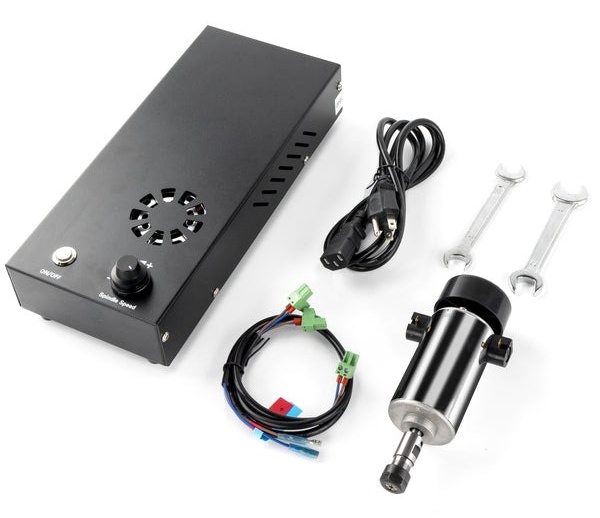
Ideal for CNC Engraving Machines
Tailored for 3018-SE V2/Masuter, this 300W upgrade boosts from stock 60W for deeper cuts in soft metals.
Compact Size and Efficient Cooling
52mm diameter x 48V; air-cooled with integrated box for heat dissipation, weighing <2kg for easy swaps.
Designed for Small CNC Routers like 3018
10,000–12,000 RPM with ER11 collet; on/off via software. FoxAlien site reviews (4.8/5) rave: "Transformed my 3018—engraved aluminum without skipping." Quiet (60 dB) for home use.
7. CNC4NEWBIE Precision Spindle Motor
Made in North America
Crafted in the U.S. with 6061-T6 aluminum, this spindle emphasizes local sourcing and custom fits for X-Carve/Shapeoko upgrades.
Durable Construction and High Precision
Rigid mounts with direct-drive leadscrews; <0.01mm accuracy via square linear bearings, supporting 500–1.5kW routers.
Excellent Upgrade for Professional Users
Handles 48" sheets; low-vibration for pro tolerances. CNC4Newbie forums (4.7/5) praise: "Rock-solid for plywood milling—U.S.-made quality shines." Modular for ATC add-ons.
8. Makita RT0701C Compact Router Spindle
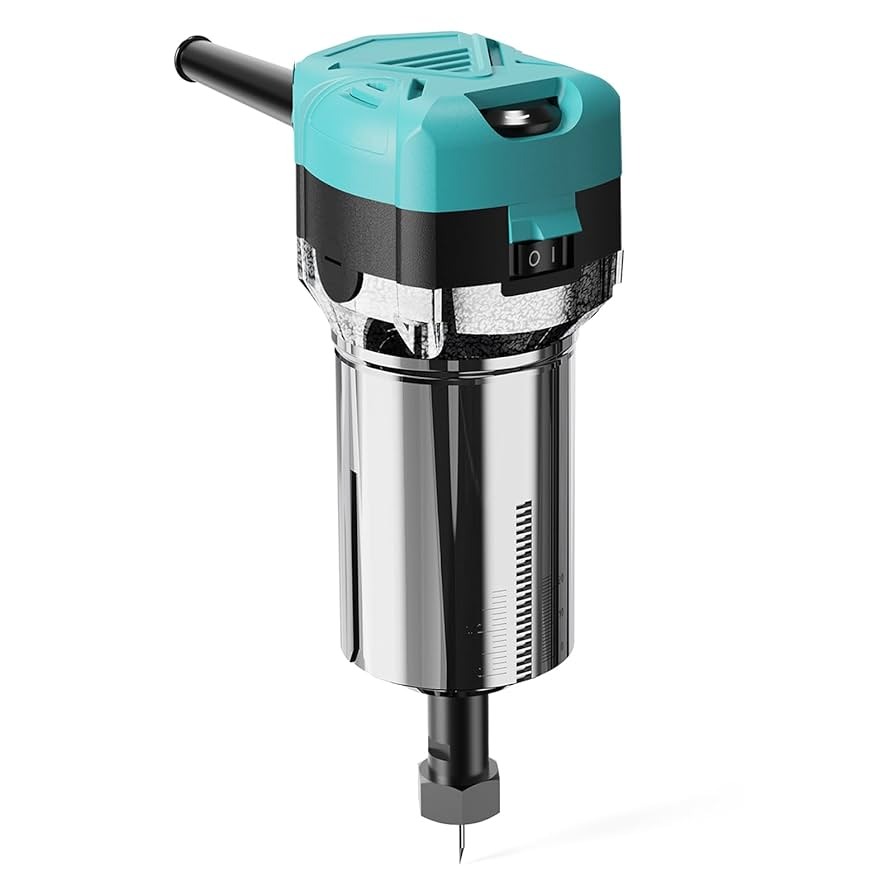
Dual-Purpose: Router and CNC Spindle
1.25HP trim router doubles as handheld tool; 65mm body fits Shapeoko without mods.
Adjustable Speed and Reliability
10,000–30,000 RPM dial; soft-start reduces startup shock, with precision collets for <0.01mm runout.
Easy Integration with DIY CNC Setups
110V plug-and-play; YouTube reviews (4.6/5) highlight versatility: "Seamless on MPCNC—cut steel proxies effortlessly." Durable for 500+ hours.
9. AMB (Kress) 1050 FME-P Spindle Motor
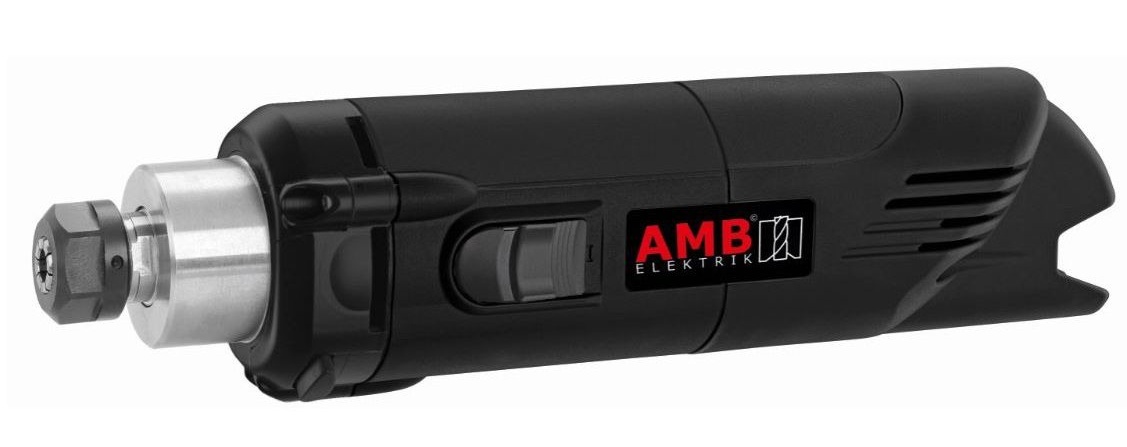
German Engineering with Top-Notch Quality
AMB (formerly Kress) delivers precision via ER16 collets and 43H7 stainless necks; 1050W for industrial-grade desktops.
Quiet Operation and Long Lifespan
74 dB at 5,000 RPM; 500–25,000 RPM with 0.01mm concentricity, brushes last 1,000 hours.
Premium Choice for Professionals
Vector control for torque in metals; StoneyCNC reviews (4.8/5): "Best value—flawless on gantry mills." Suits plexi to non-ferrous.
10. Carbide Compact Router Spindle
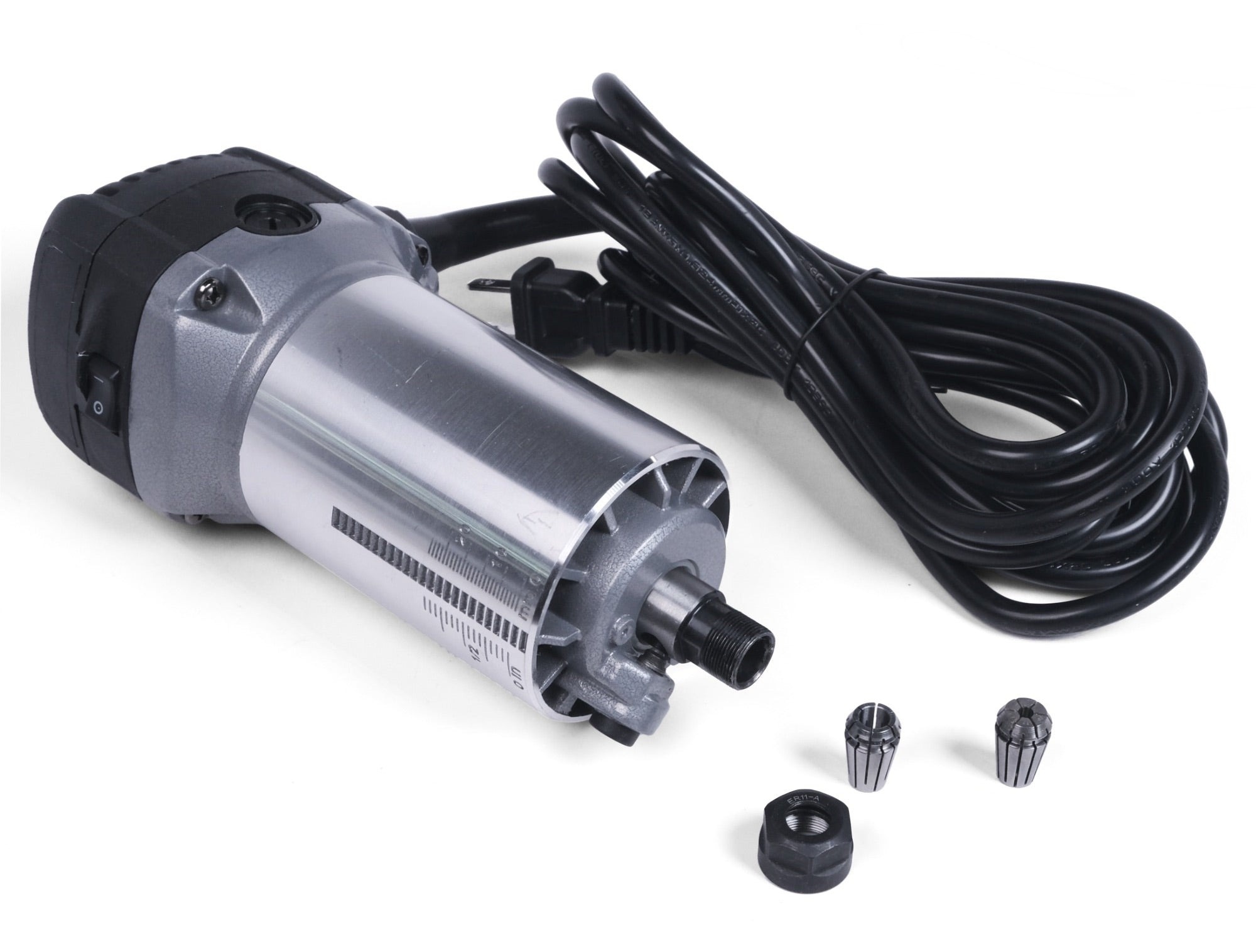
Trusted by Carbide 3D Shapeoko Users
Redesigned for Shapeoko 4/Pro; 110V/1.25HP with extended cord for easy wiring.
Balanced Performance and Excellent Support
10,000–30,000 RPM; precision collets (1/8–1/4") for <0.005mm accuracy, quiet at 70 dB.
Compatible with a Wide Range of CNC Routers
65mm mount fits most; Carbide3D forums (4.7/5): "Reliable daily driver—pro results on aluminum." Lifetime support included.
Comparison Table of Top CNC Spindle Motors
| Rank | Model | Power | RPM Range | Cooling | Price (USD) | Best For |
| 1 | Zhong Hua Jiang | 1.5kW | 0–24,000 | Water | $150–$250 | Engraving |
| 2 | Stepcraft HF-500 | 500W | 5,000–30,000 | Air | $300–$400 | Wood/Metal |
| 3 | Vevor ER11/16 | 0.8–1.5kW | 12,000–24,000 | Air | $100–$150 | Hobby |
| 4 | GDZ-65-800W | 800W | 0–24,000 | Water | $80–$120 | Carving |
| 5 | RATTMMOTOR 500W | 500W | 0–12,000 | Air | $50–$100 | DIY |
| 6 | FoxAlien 300W | 300W | 10,000–12,000 | Air | $100–$150 | 3018 Upgrades |
| 7 | CNC4NEWBIE Precision | 500W–1.5kW | Variable | Air/Water | $200–$400 | Pro Upgrades |
| 8 | Makita RT0701C | 1.25HP | 10,000–30,000 | Air | $100–$150 | Versatile |
| 9 | AMB (Kress) 1050 | 1.05kW | 5,000–25,000 | Air | $300–$500 | Premium |
| 10 | Carbide Compact | 1.25HP | 10,000–30,000 | Air | $80–$120 | Shapeoko |
How to Maintain Your CNC Spindle Motor
Proper care of your CNC spindle motor is essential for ensuring smooth operation, maintaining precision, and extending its lifespan—often from 5,000 to 30,000 hours depending on the model. Neglect can lead to vibration, bearing failure, or reduced torque, causing costly downtime or tool breakage. Follow a routine schedule: daily visual checks, weekly cleaning, monthly inspections, and annual servicing. Always power off and unplug the machine before maintenance, and consult your manufacturer's manual (e.g., for Zhong Hua Jiang or Vevor models) for model-specific guidelines. Use PPE like gloves and eye protection, and keep a log of hours run and issues for predictive maintenance.
Clean Air Inlets Regularly to Prevent Dust Buildup
Dust and chips from materials like wood or aluminum can clog air inlets on air-cooled spindles (or coolant channels in water-cooled ones), leading to overheating, thermal expansion errors (up to 0.05mm), and premature bearing wear.
· Frequency: After every 10–20 hours of use or daily in dusty environments.
· Steps:
1. Power down and remove the spindle from the CNC if possible.
2. Use compressed air (under 30 PSI) or a soft brush to clear vents, fans, and fins—avoid vacuum cleaners that create static.
3. For water-cooled: Flush channels with distilled water and mild detergent, then dry thoroughly.
4. Inspect and clean collets/nuts; wipe housing with isopropyl alcohol (90%+) and a microfiber cloth.
· Tips: Install dust boots or enclosures; for air-cooled fans, lubricate blades if accessible. This prevents 80% of heat-related failures and maintains RPM stability.
Inspect Bearings and Replace if Noise Increases
Bearings (often angular contact or ceramic hybrids) handle high-speed loads but degrade from contamination, imbalance, or overuse, manifesting as whining, grinding, or irregular vibrations that affect cut quality.
· Signs of Wear: Unusual noise (>5 dB increase), excessive runout (>0.01mm measured with dial indicator), or heat post-run (>60°C).
· Inspection Routine:
1. Run at mid-RPM (e.g., 12,000) for 5 minutes and listen/feel for anomalies.
2. Check runout by mounting a test arbor and using a dial gauge—should be <0.005mm.
3. Monthly: Disassemble if skilled, or send to a service center for grease analysis.
· Replacement:
o Use OEM or equivalent (e.g., ABEC-7 P4 grade); for ER-collet spindles, replace pairs to maintain preload.
o Tools needed: Bearing puller, press, and torque wrench for reassembly.
o Cost: $20–$100 per set; expect every 2,000–5,000 hours.
· Pro Tip: Balance rotors annually with a dynamic balancer to ISO G2.5 standards, reducing vibration-induced wear.
Avoid Overloading the Spindle During Long Runs
Overloading—exceeding rated power, torque, or duty cycle—causes stalling, motor burnout, or VFD faults, especially in desktops with limited rigidity.
· Best Practices:
o Match feeds/speeds to material: Use calculators (e.g., G-Wizard) for chip loads (0.05–0.2mm/tooth); never exceed 80% max RPM/torque.
o Limit continuous runs: <4 hours for air-cooled, <8 for water-cooled; incorporate 10–15 minute cool-downs.
o Monitor via VFD amps (should stay <90% rated); integrate current sensors for auto-shutdown.
o Upgrade frame/mounts if deflection occurs—test with rigid tapping or heavy plunge cuts.
· Monitoring: Use software like Mach4 or Fusion 360 for adaptive clearing to prevent spikes; avoid rapid direction changes without ramps.
Use a Quality VFD for Speed Control and Protection
A Variable Frequency Drive (VFD) regulates RPM, voltage, and frequency but can fail if mismatched, causing harmonics or overvoltage.
· Selection and Setup:
o Choose VFDs rated 1.5x spindle power (e.g., Huanyang or Delta for 1.5kW spindles) with vector control for constant torque.
o Parameters: Set carrier frequency >8kHz for quietness, enable overcurrent/overload protection (trips at 150% for 60s).
o Wiring: Use shielded cables, ground properly to avoid EMI; calibrate for 0–400Hz output.
· Maintenance:
o Monthly: Check fans/capacitors for dust; firmware updates via manufacturer app.
o Test protections: Simulate faults to ensure auto-shutoff.
· Benefits: Extends life by 20–30% through soft starts and dynamic braking; incompatible cheap VFDs risk spindle damage.
Store Properly When Not in Use to Prevent Corrosion
Idle spindles (e.g., >1 month) are prone to rust from humidity, especially in garages, degrading bearings and collets.
· Storage Steps:
1. Clean thoroughly and apply light machine oil (e.g., WD-40 Specialist) to shafts/collets.
2. Remove tools; store in a sealed bag or case with silica gel desiccant packets.
3. Vertical orientation to relieve bearing preload; climate control (<60% RH, 10–30°C).
4. For water-cooled: Drain fully and add antifreeze if seasonal.
· Reactivation: Run at low RPM for 30 minutes to redistribute grease before full use.
· Long-Term: Annual disassembly for inspection if stored >6 months.
| Maintenance Task | Frequency | Tools Needed | Expected Benefit |
| Clean Inlets | Daily/Weekly | Compressed air, brush | Prevents overheating |
| Bearing Inspection | Monthly | Dial gauge, stethoscope | Early wear detection |
| Overload Avoidance | Per Job | Speed calculator, VFD monitor | Prolongs motor life |
| VFD Check | Monthly | Multimeter | Stable speed control |
| Storage Prep | As Needed | Oil, desiccant | Corrosion prevention |
Regular adherence to these practices can double your spindle's ROI, minimizing repairs (often $100–$300) and ensuring consistent precision in your desktop CNC workflow. For complex issues, consult certified technicians or forums like CNCZone.
Conclusion
Choosing the right CNC spindle motor is crucial to unlocking your machine’s full potential, as it directly influences precision, efficiency, and versatility in cutting, engraving, and milling tasks. A well-matched spindle minimizes vibrations, optimizes torque for diverse materials—from soft woods to aluminum—and integrates seamlessly with desktop CNC frames like the Shapeoko or 3018 series, ensuring tolerances under 0.01mm and extending tool life. Poor selection, conversely, leads to stalling, overheating, or subpar finishes, underscoring the need to evaluate power (500W–2.5kW), RPM range (up to 48,000), cooling type, and collet compatibility against your workflow demands.
Whether you’re a hobbyist prototyping custom signs in a garage, a small workshop owner scaling production, or a professional seeking industrial-grade reliability, the options in this top 10 list offer something for every need and budget, from budget air-cooled kits under $100 to premium engineered models at $500. Brands like Vevor and RATTMMOTOR cater to beginners with plug-and-play simplicity, while Stepcraft, AMB (Kress), and CNC4NEWBIE provide pro-level quietness and durability for demanding applications. American-made or U.S.-optimized choices, such as the Carbide Compact or Makita RT0701C, emphasize easy integration and robust support, aligning with the growing DIY and automation trends in the U.S. CNC market.
Among them, the Zhong Hua Jiang CNC spindle motor shines as a robust, precise, and long-lasting solution trusted globally. With its patented air-cooled design, precision bearings for smooth operation, VFD compatibility for variable speeds, and a lifespan of up to 2 years under daily use, it delivers exceptional value for precision engraving and light milling. Backed by Huajiang's 20+ years of R&D, CE/ISO certifications, and strong U.S. availability, it transforms entry-level machines into versatile workhorses—handling everything from PCB prototyping to custom signage with minimal noise and maintenance. User acclaim for its stability and ROI makes it a standout for both novices and pros looking to elevate their setups without complexity.
Ultimately, invest time in matching specs to your materials and machine, prioritize maintenance routines like regular cleaning and bearing checks, and leverage VFD protections for longevity. As the American CNC landscape evolves with reshoring and automation, selecting a reliable spindle like Zhong Hua Jiang not only boosts productivity but positions you for sustainable, high-quality output in an increasingly competitive maker economy. Explore user reviews, test compatibility, and start small to scale—your ideal spindle awaits to power endless creativity.
Click here to download Zhong Hua Jiang's Catalogue.
 Zhong Hua Jiang Catalogue 2025.pdf
Zhong Hua Jiang Catalogue 2025.pdf
English
简体中文
繁體中文
العربية
Français
Русский
Español
Português
Deutsch
italiano
日本語
한국어
Nederlands
Tiếng Việt
ไทย
Polski
Türkçe
አማርኛ
ພາສາລາວ
ភាសាខ្មែរ
Bahasa Melayu
ဗမာစာ
தமிழ்
Filipino
Bahasa Indonesia
magyar
Română
Čeština
Монгол
қазақ
Српски
हिन्दी
فارسی
Kiswahili
Slovenčina
Slovenščina
Norsk
Svenska
українська
Ελληνικά
Suomi
Հայերեն
עברית
Latine
Dansk
اردو
Shqip
বাংলা
Hrvatski
Afrikaans
Gaeilge
Eesti keel
Māori
සිංහල
नेपाली
Oʻzbekcha
latviešu
অসমীয়া
Aymara
Azərbaycan dili
Bamanankan
Euskara
Беларуская мова
भोजपुरी
Bosanski
Български
Català
Cebuano
Corsu
ދިވެހި
डोग्रिड ने दी
Esperanto
Eʋegbe
Frysk
Galego
ქართული
guarani
ગુજરાતી
Kreyòl ayisyen
Hausa
ʻŌlelo Hawaiʻi
Hmoob
íslenska
Igbo
Ilocano
Basa Jawa
ಕನ್ನಡ
Kinyarwanda
गोंगेन हें नांव
Krio we dɛn kɔl Krio
Kurdî
Kurdî
Кыргызча
Lingala
Lietuvių
Oluganda
Lëtzebuergesch
Македонски
मैथिली
Malagasy
മലയാളം
Malti
मराठी
ꯃꯦꯇꯥꯏ (ꯃꯅꯤꯄꯨꯔꯤ) ꯴.
Mizo tawng
Chichewa
ଓଡ଼ିଆ
Afaan Oromoo
پښتو
ਪੰਜਾਬੀ
Runasimi
Gagana Samoa
संस्कृत
Gaelo Albannach
Sepeti
Sesotho
chiShona
سنڌي
Soomaali
Basa Sunda
Wikang Tagalog
Тоҷикӣ
Татарча
తెలుగు
ትግንያውያን
Xitsonga
Türkmençe
संस्कृत
ئۇيغۇرچە
Cymraeg
isiXhosa
ייִדיש
Yorùbá
isiZulu
























